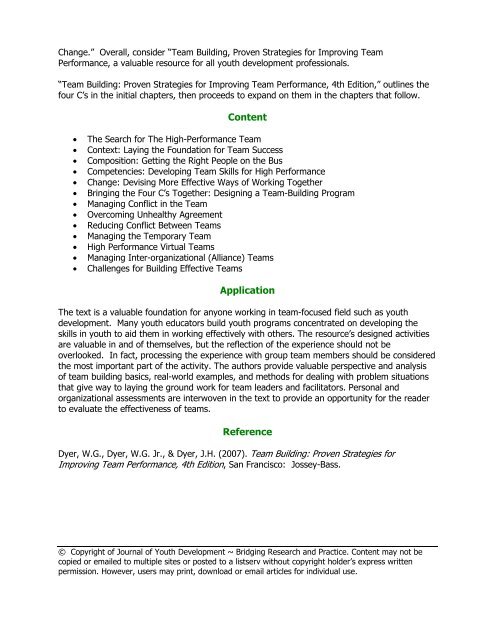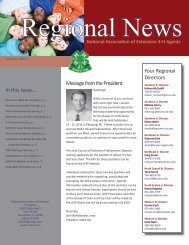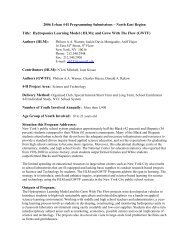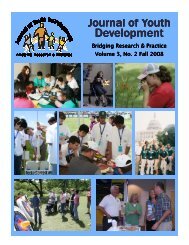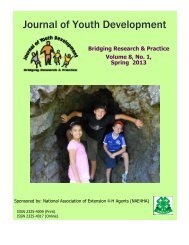Winter 2008 - Vol. 3 No. 3 - National Association of Extension 4-H ...
Winter 2008 - Vol. 3 No. 3 - National Association of Extension 4-H ...
Winter 2008 - Vol. 3 No. 3 - National Association of Extension 4-H ...
- No tags were found...
You also want an ePaper? Increase the reach of your titles
YUMPU automatically turns print PDFs into web optimized ePapers that Google loves.
Change.” Overall, consider “Team Building, Proven Strategies for Improving TeamPerformance, a valuable resource for all youth development pr<strong>of</strong>essionals.“Team Building: Proven Strategies for Improving Team Performance, 4th Edition,” outlines thefour C’s in the initial chapters, then proceeds to expand on them in the chapters that follow.Content• The Search for The High-Performance Team• Context: Laying the Foundation for Team Success• Composition: Getting the Right People on the Bus• Competencies: Developing Team Skills for High Performance• Change: Devising More Effective Ways <strong>of</strong> Working Together• Bringing the Four C’s Together: Designing a Team-Building Program• Managing Conflict in the Team• Overcoming Unhealthy Agreement• Reducing Conflict Between Teams• Managing the Temporary Team• High Performance Virtual Teams• Managing Inter-organizational (Alliance) Teams• Challenges for Building Effective TeamsApplicationThe text is a valuable foundation for anyone working in team-focused field such as youthdevelopment. Many youth educators build youth programs concentrated on developing theskills in youth to aid them in working effectively with others. The resource’s designed activitiesare valuable in and <strong>of</strong> themselves, but the reflection <strong>of</strong> the experience should not beoverlooked. In fact, processing the experience with group team members should be consideredthe most important part <strong>of</strong> the activity. The authors provide valuable perspective and analysis<strong>of</strong> team building basics, real-world examples, and methods for dealing with problem situationsthat give way to laying the ground work for team leaders and facilitators. Personal andorganizational assessments are interwoven in the text to provide an opportunity for the readerto evaluate the effectiveness <strong>of</strong> teams.ReferenceDyer, W.G., Dyer, W.G. Jr., & Dyer, J.H. (2007). Team Building: Proven Strategies forImproving Team Performance, 4th Edition, San Francisco: Jossey-Bass.© Copyright <strong>of</strong> Journal <strong>of</strong> Youth Development ~ Bridging Research and Practice. Content may not becopied or emailed to multiple sites or posted to a listserv without copyright holder’s express writtenpermission. However, users may print, download or email articles for individual use.


